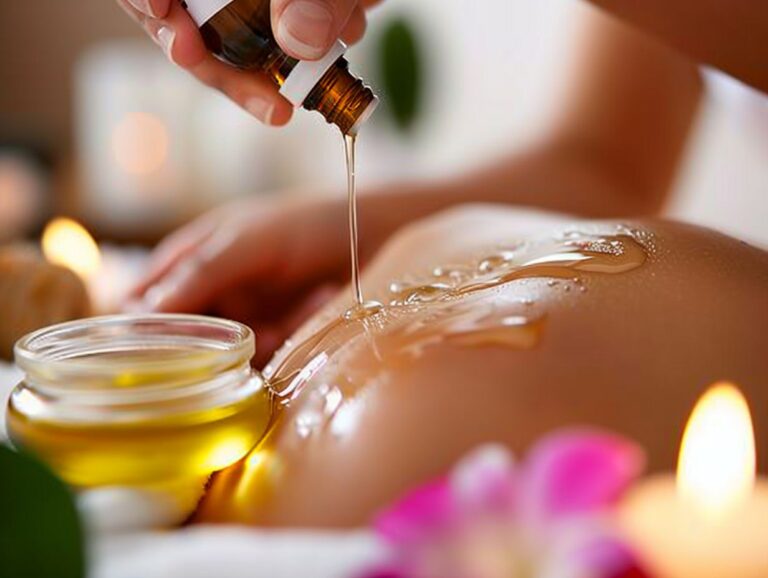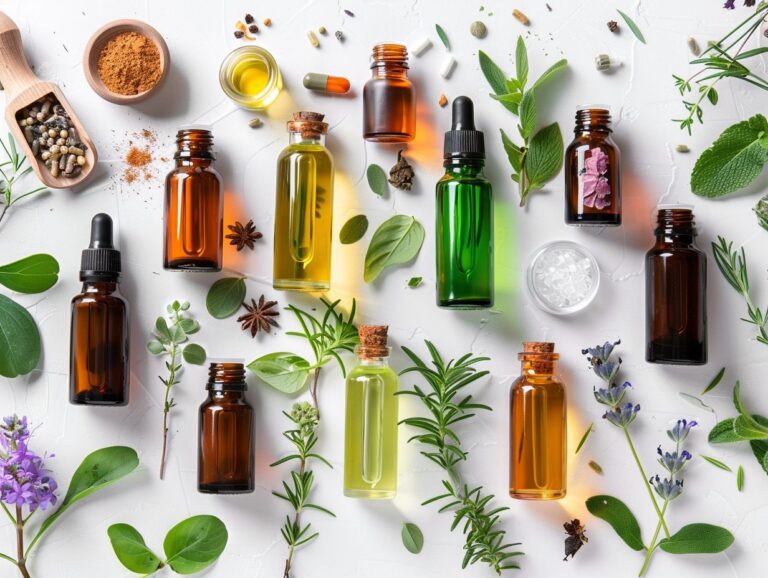What Kind of Oil is in Essential Oils
Have you ever wondered about the magic behind essential oils? From their creation to the various types available, essential oils offer a wide range of benefits, from aromatherapy to stress relief and skin care.
We will explore how these oils are made, the different types available such as citrus, floral, herbal, spicy, and woody oils, as well as the safety precautions for using them.
Discover the world of essential oils and the kind of oil they contain!
Key Takeaways:
What Are Essential Oils?
Essential oils are natural plant extracts that are highly concentrated and possess distinctive properties and aromas. They are typically extracted through methods like distillation or cold pressing.
Regarding essential oils, their concentrated nature makes them powerful and effective in various applications, including aromatherapy, skincare, and holistic wellness practices. Dr. Lin, a renowned expert in the field, has extensively studied the therapeutic benefits of essential oils and their impact on well-being. These oils retain the essence of the plants they are derived from, maintaining the unique fragrance and healing properties that make them so valuable.
How Are Essential Oils Made?
Essential oils are made through the process of extracting volatile compounds from plants. The most common methods include distillation, cold pressing, or solvent extraction.
Distillation is a method that involves heating the plant material to release the volatile oils, which are then condensed and collected. Cold pressing is typically used for citrus fruits, where the peel is mechanically pressed to extract the oil. Solvent extraction, on the other hand, uses a solvent such as hexane to pull out the essential oils from the plant material.
These volatile compounds not only carry the characteristic fragrance of the plant but also contain therapeutic properties that can benefit our well-being.
What Are the Different Types of Essential Oils?
Essential oils come in various types, including Citrus Oils, Floral Oils, Herbal Oils, Spicy Oils, and Woody Oils. Each type offers unique benefits and aromas.
Citrus oils, like Lemon and Sweet Orange, are uplifting and refreshing, known for their bright, energizing scents that can boost mood and increase focus.
Floral oils, such as Lavender and Rose, are calming and soothing, often used for relaxation and promoting sleep with their gentle, flowery fragrances.
Herbal oils like Tea Tree Oil and Peppermint Oil are renowned for their cleansing and invigorating properties, commonly used for skin care and respiratory support.
Spicy oils, including Cinnamon and Clove, have warming and stimulating effects, often used for their antibacterial and immune-boosting properties.
Woody oils, like Sandalwood and Cedarwood, have grounding and calming attributes, frequently utilized in meditation and relaxation practices.
Citrus Oils
Citrus oils, such as Orange oil and Bergamot, are known for their refreshing aroma and skin benefits. They are often used in skincare products for their invigorating properties.
Citrus oils have gained popularity in skincare routines due to their ability to promote a radiant complexion and improve skin texture. These oils are rich in antioxidants, which help combat free radicals and protect the skin from environmental stressors.
Their uplifting scents can enhance mood and create a spa-like experience during skincare rituals. It is essential to dilute citrus oils properly before applying them to the skin to prevent irritation or sensitivity. Adhering to safety guidelines, such as performing a patch test and avoiding sun exposure after application, is crucial for enjoying the full benefits of these botanical extracts.
Floral Oils
Floral oils like Rosemary oil and Lemongrass offer a delightful aroma and various health benefits. These oils are often used in aromatherapy for their soothing effects.
The wide array of floral oils available in the market provides a natural way to relax and rejuvenate. Rosemary oil, for instance, is known for its invigorating scent that can help improve focus and concentration. On the other hand, Lemongrass oil boasts a fresh, citrusy aroma that can uplift the mood and combat feelings of stress and anxiety.
Aromatherapy, a holistic approach to well-being, utilizes these floral oils to promote relaxation, reduce inflammation, and even improve sleep quality. The healing properties of these oils can stimulate the senses and create a tranquil atmosphere, making them popular choices in spa treatments and home diffusers.
Herbal Oils
Herbal oils, such as Rosehip oil and Eucalyptus oil, are valued for their medicinal properties. These oils are commonly used in integrative medicine for their therapeutic benefits.
Rosehip oil, derived from the seeds of the rose bush, is rich in essential fatty acids, antioxidants, and vitamins A and C, making it a popular choice for skincare. It is known for its ability to hydrate, rejuvenate, and improve skin elasticity, helping with conditions like acne, scars, and wrinkles.
Eucalyptus oil, extracted from the eucalyptus tree leaves, is celebrated for its anti-inflammatory, antiseptic, and decongestant properties. It is often used in aromatherapy to clear the mind, relieve respiratory issues, and soothe muscle pains.
Spicy Oils

Spicy oils such as Cedarwood oil are known for their warm and earthy aroma.
Recent research has delved into the unique properties of Cedarwood oil, revealing its potential to promote relaxation and reduce anxiety due to its calming effects on the nervous system. One study published in the Journal of Alternative and Complementary Medicine found that inhaling Cedarwood oil can decrease levels of cortisol, the stress hormone, in the body, leading to a more relaxed state.
The Journal of Experimental Botany reported that Cedarwood oil possesses anti-inflammatory and antioxidant properties, making it beneficial for supporting overall well-being. These findings suggest that incorporating Cedarwood oil into aromatherapy practices may offer a natural and effective way to manage stress and enhance mental health.
Woody Oils
Woody oils, such as Sandalwood oil and Patchouli oil, are often used as carrier oils in aromatherapy. Their grounding scents make them popular choices for blending with other essential oils.
These oils not only have a pleasant aroma but also offer therapeutic benefits when used in combination with other essential oils. One of the key advantages of using woody oils as carriers is their ability to balance out the strong scents of oils like citrus or florals, creating a more well-rounded fragrance.
When blending, it’s essential to consider the compatibility of scents and their respective therapeutic properties. Expert aromatherapists recommend starting with a base note like Sandalwood or Patchouli and adding top notes like Lavender or Citrus for a harmonious blend.
What Are the Benefits of Essential Oils?
Essential oils offer a wide range of benefits, including promoting relaxation, improving skin health, and supporting overall well-being. Their aromatic properties can positively impact both physical and emotional health.
Aromatherapy plays a significant role in harnessing these benefits, as it involves the use of natural plant extracts to enhance well-being. Whether diffused, inhaled, or applied topically, essential oils can alleviate stress, calm the mind, and promote a sense of tranquility. From lavender for its calming effects to peppermint for invigorating the senses, each oil offers unique properties. These oils can aid in skincare by reducing blemishes, fighting acne, and moisturizing the skin naturally. When used correctly, essential oils can be powerful tools for holistic health and self-care.
Aromatherapy
Aromatherapy harnesses the power of essential oils to stimulate sensory neurons and promote relaxation. The absorption of aromatic compounds can have a calming effect on the mind and body.
When essential oils are inhaled, their molecules travel through the nose and directly interact with the olfactory system, triggering a response in the limbic system of the brain – the area responsible for emotions and memories. This process can lead to the release of neurotransmitters like serotonin and dopamine, promoting feelings of happiness and relaxation.
Plus inhalation, essential oils can also be absorbed through the skin. When applied topically, these oils penetrate the skin and enter the bloodstream, where they can have a direct impact on the body’s physiological responses. This dual pathway of absorption contributes to the holistic benefits of Aromatherapy, offering a multi-faceted approach to enhancing emotional well-being.
Stress Relief
Essential oils are commonly used for stress relief due to their calming effects on the nervous system. The gentle aromas can trigger positive reactions in the body, promoting a sense of relaxation.
When inhaled, the essential oils travel through the olfactory system, interacting with the brain’s limbic system responsible for emotions and memory. This interaction can lead to reduced levels of the stress hormone cortisol, helping to lower anxiety levels.
Different scents like lavender, chamomile, and rosemary have been studied for their ability to induce calmness and relaxation. The therapeutic properties of these oils can also support better sleep, which is often disrupted by stress and tension.
Skin Care
Essential oils play a vital role in skincare by offering moisturizing properties and addressing various skin concerns.
It is essential to consider skin type and potential reactions, as certain oils may cause irritation.
When incorporating essential oils into your skincare routine, understanding their individual benefits and compatibility with your skin type is crucial. Different oils have unique properties that can help hydrate, soothe, or even rejuvenate the skin.
- Jojoba oil, for example, is known for its ability to mimic the skin’s natural oils, making it a fantastic choice for all skin types, especially those prone to dryness.
- On the other hand, tea tree oil is celebrated for its antibacterial and antimicrobial properties, making it ideal for acne-prone or oily skin.
It’s important to dilute essential oils properly before application to avoid adverse reactions, as their concentrated nature can sometimes lead to irritation or sensitivities.
Pain Relief
Certain essential oils like Lavender and Peppermint are known for their analgesic properties, making them effective for pain relief. It’s crucial to be aware of potential side effects and proper dilution methods.
When using essential oils for pain relief, it is essential to dilute them properly to prevent skin irritation or other adverse reactions. Dilution ratios vary depending on the oil, so it’s recommended to follow guidelines closely. For instance, a general rule of thumb is to use a carrier oil like coconut or jojoba oil to dilute the essential oil before applying it topically.
While essential oils can be a natural and holistic option for pain management, they may not be suitable for everyone. It’s important to do a patch test before widespread use to check for any allergic reactions. Certain oils like Wintergreen can be toxic if ingested, emphasizing the need for cautious handling and storage.
What Are the Safety Precautions for Using Essential Oils?

Choosing the right carrier oil is essential when diluting essential oils. Some popular carrier oils include coconut oil, jojoba oil, almond oil, and olive oil. Each carrier oil has its own characteristics and benefits, so it’s important to select one that complements the properties of the essential oil you are using.
To ensure proper dilution, it is recommended to follow guidelines such as using a 2-3% dilution ratio for adults and a lower ratio for children or those with sensitive skin. Always perform a patch test before widespread use to check for any adverse reactions.
Dilution
Dilution is key when using essential oils to ensure safe application and effective absorption. Carrier oils like Coconut oil or Jojoba oil are commonly used to dilute essential oils for topical use.
When using essential oils topically, it is crucial to dilute them properly to avoid skin irritation or sensitization. Carrier oils act as a medium to help distribute the concentrated essential oils over a larger skin area, reducing the risk of adverse reactions. Coconut oil and Jojoba oil are popular carrier oils due to their nourishing properties and compatibility with most skin types.
Proper dilution ratios are essential for safe usage. A common guideline is to use a 2-3% dilution rate for adults, which translates to about 12-18 drops of essential oil per ounce of carrier oil. For children, elderly, or those with sensitive skin, a lower dilution of 1% or less is recommended.
Patch Test
Performing a patch test before using new essential oils is essential to check for skin reactions or sensitivities. Apply a small amount of diluted oil to a small area to assess any adverse skin responses.
When conducting a patch test, it is crucial to select a discreet area like the inner forearm and ensure the skin is free of any cuts or irritations. By doing this, you can observe any signs of redness, itching, swelling, or irritation that may indicate an allergic reaction.
Remember, essential oils are potent substances that can cause adverse effects if not properly diluted or used without caution. Patch testing is a simple yet effective method to safeguard your skin and prevent any potential discomfort or harm from these concentrated oils.
Avoiding Certain Oils During Pregnancy
During pregnancy, it’s important to avoid certain essential oils that may pose risks to maternal and fetal health. Consultation with a healthcare provider is advisable before using any essential oils during pregnancy.
Some essential oils, such as clary sage, rosemary, basil, and cedarwood, are typically recommended to be avoided during pregnancy due to their potential effects on hormone levels and uterine contractions. It’s crucial to prioritize safety and well-being during this sensitive time. Seeking guidance from healthcare professionals can help ensure that the essential oils used are safe and suitable.
Always dilute essential oils properly and perform a patch test before using them to reduce the risk of skin irritation. The well-being of the mother and baby should be the top priority, and with proper care and guidance, essential oils can be incorporated safely into a pregnancy routine.
Can Essential Oils Be Ingested?
The ingestion of essential oils is a topic of debate in the natural health community. While some advocate for internal use for certain oils, caution and expert guidance are advised due to potential health risks.
Many natural health enthusiasts believe that consuming essential oils internally can offer a wide range of benefits, from digestive support to immune system strengthening. Opposing views highlight the dangers associated with ingesting concentrated plant extracts. Some experts argue that essential oils are highly potent and should not be taken internally without professional supervision. Improper use or dosage of essential oils can lead to adverse reactions, toxicity, and other health complications. As a result, it is crucial for individuals to conduct thorough research and consult with a qualified healthcare provider before considering internal use of essential oils.
What Kind of Oil is in Essential Oils?
Essential oils are typically extracted and concentrated plant essences, distinct from carrier oils that are used to dilute them. Carrier oils like Olive oil or Coconut oil aid in the absorption of essential oils into the skin.
Carrier oils play a crucial role in skincare routines and aromatherapy practices by acting as a base to dilute potent essential oils, ensuring they are safe for direct application on the skin.
These oils are also valued for their ability to enhance the therapeutic benefits of essential oils, promoting better skin penetration and reducing the risk of skin irritation.
Carrier Oils
Carrier oils serve as a base for diluting essential oils and aid in their absorption into the skin. They also provide additional moisturizing benefits, making them essential in topical applications.
Carrier oils play a crucial role in ensuring that essential oils are applied safely to the skin without causing irritation or adverse reactions. By diluting the concentrated essential oils, carrier oils help to reduce their potency, making them more suitable for direct application.
Jojoba oil, for example, is known for its similarity to the skin’s natural oils, making it an excellent moisturizer that can deeply penetrate the skin without clogging pores. Its lightweight nature allows it to absorb quickly, carrying essential oils along with it for a more effective application.
Olive oil, on the other hand, is rich in antioxidants and vitamins, making it a nourishing option for the skin. Its emollient properties help to soften and hydrate the skin, enhancing the benefits of essential oils when combined in skincare routines.
Infused Oils

Infused oils are versatile and can be used in skincare products like lotions, balms, and creams, providing nourishment and enhancing the overall benefits of the product. The process of infusion involves allowing the plant material to sit in the carrier oil for a period of time, allowing the oil to absorb the scent and therapeutic qualities. Infused oils often retain the natural attributes of the plants, offering a holistic approach to wellness. Common examples include lavender-infused oil for relaxation and chamomile-infused oil for soothing irritated skin. These oils are popular in aromatherapy for their calming and rejuvenating effects.
Synthetic Oils
Synthetic oils are artificially created aromatic compounds designed to mimic natural scents. While they offer consistent fragrance profiles, concerns exist regarding their impact on health and environment.
Synthetic oils are widely used in the fragrance industry due to their cost-effectiveness and ability to replicate popular scents. Manufacturers have the flexibility to customize the scent profiles of synthetic oils to cater to specific market preferences, making them a versatile option for perfumes, candles, and personal care products. Synthetic oils lack the complexity and depth of natural essential oils, which are extracted from plant materials through distillation or cold-pressing methods.
Frequently Asked Questions
What kind of oil is in essential oils?
Essential oils are concentrated liquids that are extracted from various plants. They contain the natural oils and compounds from the plant, such as its fragrance and flavor. The type of oil in an essential oil depends on the plant it is extracted from. For example, lavender essential oil contains the oils from the lavender plant.
Do all essential oils contain the same type of oil?
No, different plants have different types of oils, and therefore, different essential oils will have varying types of oil. For example, peppermint essential oil contains menthol, while tea tree essential oil contains terpinene-4-ol. These are two different types of oils found in different plants.
What are the most common types of oil found in essential oils?
Some of the most common types of oils found in essential oils include terpenes, esters, aldehydes, ketones, and phenols. These are all natural compounds that are found in plants and contribute to the unique properties and benefits of each essential oil.
Are essential oils safe to use on the skin?
While essential oils are derived from natural sources, they are highly concentrated and can be potent. Some essential oils can cause skin irritation or allergic reactions when used directly on the skin, so it is important to dilute them with a carrier oil before applying to the skin. It is also important to do a patch test before using any essential oil topically.
Can essential oils be ingested?
Not all essential oils are safe to ingest, and it is important to check with a healthcare professional before doing so. Some essential oils may be toxic if ingested, while others may have a safe recommended dosage. It is always best to use essential oils as directed and to consult with a professional if unsure.
What kind of oil is used to dilute essential oils?
Carrier oils are used to dilute essential oils before applying them topically. These can include oils such as coconut, almond, jojoba, or grapeseed oil. These oils help to reduce the potency of essential oils and make them safer to use on the skin.







